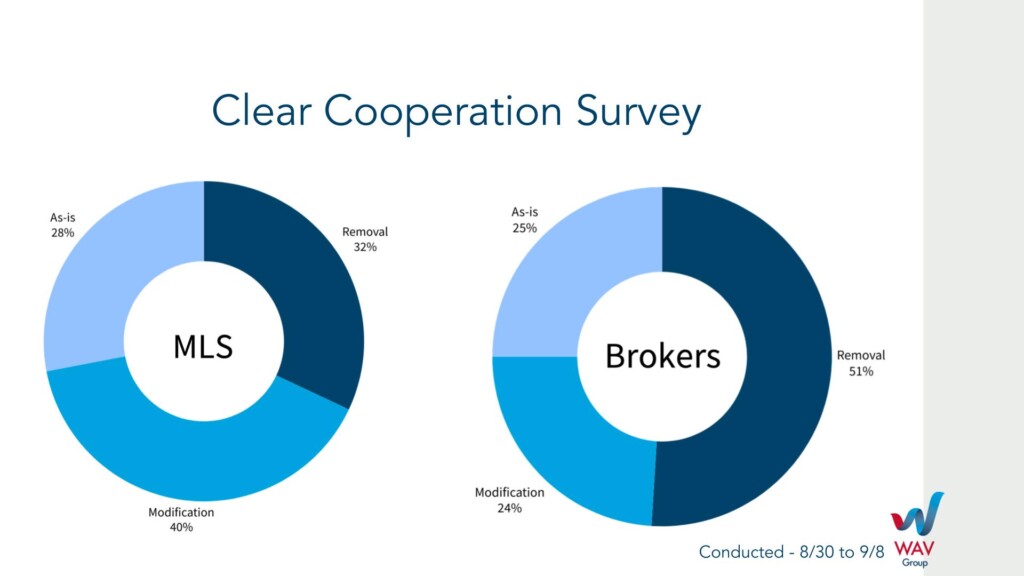At WAV Group, we are passionate about finding ways to ensure the long-term success of the real estate industry by protecting the best interests of real estate consumers. The on-going spirited debate around the Clear Cooperation Policy centers around different brokerage and MLS beliefs about the ways to serve real estate consumers.
In our recent WAV Group Clear Cooperation Study, 670 real estate brokerages and MLS staff and leadership weighed in on where we should take this Clear Cooperation Policy. We fielded this study to collect data for our MLS and Brokerage clients and the Emerging Issues Committee. The survey provides data to fuel discussions about how to serve the best interests of the consumer, while allowing brokerages to deliver service to consumers with their own unique twist.
While overall 43% (MLS and Broker) of respondents believe the rule should be rescinded, when looking deeper into the data, we found that 51% of brokers want the rule to be removed.
The cohort of brokers wanting the policy removed included large, medium, and small firms. Large brokers were the least supportive of the rule. Their largest motivation to get rid of the rule is the fear of getting sued AGAIN. Many of the brokerages in the “$2 billion club” are still in the middle of lawsuits and settlement negotiations from the NAR Antitrust Commission Price Fixing Lawsuit, inspired by NAR Policy. Large brokerages are not interested in opening themselves up to yet another round of litigation. Small firms were less concerned about the litigation, but provided a wide range of criticisms. Generally, they believe the MLS worked just fine before CCP, and they believe that sellers should be able to drive the process of working with their broker to sell their property.
The legal concern from the DOJ and potentially from seller class action is not an idle threat. The discussion around Clear Cooperation has been elevated to a crisis because of on-going lawsuits. There was a settlement reached between the PLS.com, now called the NLS.com with NAR and three leading MLSs. Currently there is another lawsuit under way between NAR and The Top Agent Network. On Nov. 3, 2025, trial will begin with Top Agent Network, Inc.(TAN) vs. the National Association of REALTORS®. The crux of the case is the Clear Cooperation policy. TAN alleges that NAR and the San Francisco Association of REALTORS® have used the policy to “monopolize” real estate services and, in turn, blacklist TAN. These listing networks position themselves as MLS systems without the heavy hand of the trade association acting as a monopoly – and the DOJ seems to agree.
While MLS leadership wants to help protect itself and the brokerages it serves, 72% of this audience believes there may be a way to either un-require or rework the policy to serve the needs of real estate consumers and still provide brokerages with the marketing flexibility they are looking for.

I fundamentally believe that the MLS is a mechanism that supports consumer transparency by providing the most comprehensive, accurate, and timely information about the housing marketplace. By agreeing to participate in the MLS, or a Broker Listing Cooperative as some markets describe it, each participant is doing everything in their power to ensure full consumer transparency. Not only is the MLS non-exclusive today, these organizations also facilitate distribution of listing content to thousands of websites providing tons of listing transparency to consumers via hundreds of third party portals AND thousands of agent and broker websites via IDX. Long before the Clear Cooperation Policy, MLSs required cooperation – every listing in a brokerage, other than those specifically requested by a homeowner, were shared widely among real estate practitioners and millions of potential home buyers nationwide and even around the world. The spirit of the MLS is to provide consumers with the best opportunity for buyers to find the home of their dreams and for sellers to maximize the return on their investment.
Now let’s talk about where the Clear Cooperation Policy (CCP) and Private listing networks came from. They were born in high end markets like Los Angeles and San Francisco where there was limited inventory, especially for multi-million dollar homes. Some Sellers in these markets desired a different marketing process of their property that supports their privacy needs. CCP was driven by an industry belief that by limiting exposure of these high-end homes to only select real estate agents and their networks of home buyers, home sellers were not getting the benefit of comprehensive exposure to all real estate agents locally and nationally.
These private listing networks are not prevalent in most parts of the country, however. One could argue that using the Clear Cooperation Policy in markets where they are predominant may make more sense than requiring every market in the country to solve a problem that does not exist.
The PLS.com, now called TheNLS.com, for example, claimed 20,000 agents nationwide at its height. It is not operational currently. They claim that the CCP put them out of business because they focused on marketing coming soon listings. Relative to the 1.5 million agents that have access to Realtors Property Resource and the majority of licensed real estate agents that subscribe to MLSs nationwide, that number is not that significant. TheNLS.com also claims that real estate licenses have to pay “exorbitant fees” for MLS services. In our research, I have never seen a market that charges more than $75 per month for MLS services and most are significantly less than that. TheNLS.com, according to their website, charges $199 per year and for that price does not include the plethora of technologies, training and listing syndication capabilities that MLSs deliver today. On average, our research shows that MLSs offer more than 10 technologies in addition to the core MLS system and facilitate promotion of listings on thousands of IDX sites, hundreds of third party portals and in many cases their own MLS consumer-facing site and mobile apps. as well.
With all that said, the industry always needs to continue to try to find ways to improve its ability to deliver more transparency to real estate consumers and better serve their brokerages customers.
After speaking with several MLS leaders and brokerages about the study, there are several suggestions we believe are worth considering:
5 Ways to Address the Clear Cooperation Crisis
- Make the Policy more clearly non-exclusive
While there is nothing in the current Clear Cooperation policy that requires exclusive participation in the MLS, MLS Policy can more clearly describe that entering listings into the MLS is non-exclusive. There is nothing that prevents a brokerage from posting their listing in BOTH the MLS and other listing networks. Brokers put listings in more than one MLS all of the time. This should be an easy policy to adopt.
- Create Private Listing Network within the MLS
For situations where a homeowner would prefer to expose their home privately while they prepare it, test the price point, or simply stay out of the public eye, MLSs can offer their own Private Listing Network like the one offered in the greater Chicago area at MRED.This service, launched well-before the Clear Cooperation Policy went into place and is a great solution, according to Chicagoland brokers. Read the White Paper to learn all about the Private Listing Network here. This network allows an agent to expose a listing to the entire database of real estate professionals in the MLS without syndicating it on IDX, but the listing can be advertised via yard signs, public websites and print media. Here’s a summary of how MRED modified its rules to accommodate their Private Listing Network (PLN):
- PLN listings do not require a specific listing price. Options include: none, price, or price range.
- Photos are not mandatory.
- All MRED subscribers have access to the PLN database, not just an exclusive subset of real estate practitioners.
- PLN listings are not sent to third-party portals nor are they part of IDX/VOW listing distribution.
- Listings must be entered into the PLN within 48 hours of the list date or 24 hours of advertising to the general public, whichever comes first. Public advertising includes mediums such as for sale signs, public websites, and print media.
- If a transaction closes while the listing is in the PLN, MRED subscribers are required to transition listings from the PLN into sold status, where they input all required fields for the listing so that it can be used as a comp.
- Withhold from MLS entirely – MRED also provides the option to withhold a listing from the MLS entirely at the direction of the seller, who must sign a form. Per MRED rules, these listings may not be marketed to the general public on an open website, for sale signs, or publicly accessible print advertising.
Other key considerations:
- A signed listing agreement is required for PLN listings.
- Brokerages may receive and display a feed of their own PLN listings.
- Agents can attach agent-only comments on PLN listings such as the date available for showing, open house information, additional compensation information, etc.
- Require a Seller Disclosure for Limited Exposure
If your MLS does not want to offer a private listing network, but there are cases when a seller has agreed to limit exposure to certain real estate practitioners, the MLS can create a disclosure clearly highlighting the consumer has agreed to sell their home without exposing it to the entire MLS network of practitioners. If the seller chooses a different marketing path, the MLS should not get in the way of their decision, but it can ensure the consumer is completely clear on the benefits and potential risks of limited exposure for their property.
- Enable Syndication to other Private Listing Networks
MLSs syndicate listings to hundreds of third-party websites every day. If Private Listing Networks believe they are at a disadvantage, then why can’t an MLS enable a Private Listing Network to receive a data feed like so many other sites do. Listhub, for example, syndicates listings to hundreds of sites in 50 states and serves 60,000 brokers today. The mechanism exists. Simply allow brokers to go into their ListHub account and opt-in to a site they believe will provide the optimal marketing approach for their clients.
- Un-require or Discontinue Clear Cooperation and Lean in on Consumer Transparency Created by MLSs
Let each local MLS market decide for itself whether it needs the covenants of the Clear Cooperation Policy to orchestrate the best interests for consumers. Every MLS already has the requirement that all participating broker’s listings need to be in the MLS and that suffices in many markets.
MLSs have served the best interest of consumers by first monitoring listings to be sure they adhere to Fair Housing guidelines and ensure consumer privacy with private remarks. MLSs also integrate public records, the government sanctioned record of the accurate description of a property. Third, MLS rules already require inclusion of all listings from a participating brokerage, ensuring a comprehensive, and timely exposure of listings for potential home buyers and renters. Fourth, the MLS facilitates even more consumer transparency by distributing listings to thousands of third-party portals, broker/agent websites and in many cases, MLS consumer websites as well. Fifth, the MLS allows brokers to leverage their own historical data for their own use and enables brokers to move their listings history from one MLS to another as they see fit. And finally, MLSs provide the ability to educate consumers about market trends.
These strategies can help address the challenges posed by the Clear Cooperation Policy while ensuring the real estate industry continues to prioritize transparency and consumer interests.The industry needs to more aggressively promote all the ways MLSs, with the support of real estate professionals, make it easier for consumers to find the home of their dreams and build generational wealth.





“There is nothing that prevents a brokerage from posting their listing in BOTH the MLS and other listing networks.”
You misunderstand the effect of this policy on any MLS or any brokerages. Brokerages are NOT opening themselves up to yet another round of litigation, because brokerages are victims of the policy – this is exactly what is alleged in TAN v. NAR that brokers do not have alternative (better) MLSs to serve THEM, they are harmed parties under law. The market here is not for services of real estate brokers (such as Sitzer-Burnett case) but for services MLSs provide directly to BROKERS.
There is nothing that prevents brokers from “posting their listing in BOTH the MLS and other listing networks” but the policy does prevent to use ONLY ONE MLS without the other. Specifically, using the NAR-affiliated MLS is REQUIRED if any other MLS is also used. This means that no alternative MLS can take market share away from NAR-affiliated MLS. MLSs compete for unique data, not just data that is shared everywhere.
The equivalent of this policy is such that a dominant selling platform REQUIRES sellers to place all thier items into the platform, even if a seller thinks that another platform can sell them better or cheaper. The CCP is illegal, plain and simple. There is no defense to any agreement that restrains trade, especially where NAR-affiliated MLSs control 99% of the nationwide market.